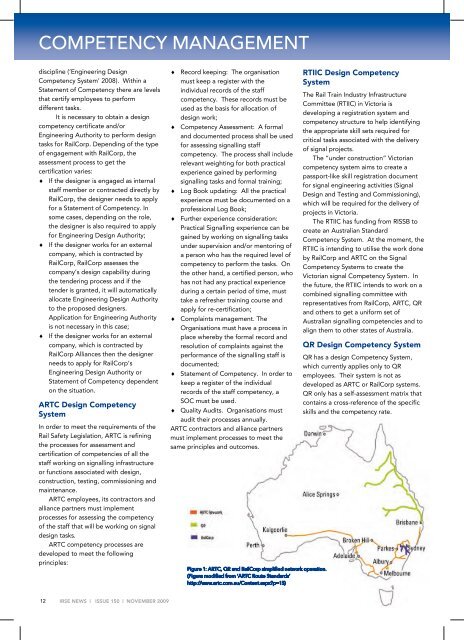IRSE News 150 Nov 09.pdf
IRSE News 150 Nov 09.pdf
IRSE News 150 Nov 09.pdf
Create successful ePaper yourself
Turn your PDF publications into a flip-book with our unique Google optimized e-Paper software.
COMPETENCY MANAGEMENT<br />
discipline (‘Engineering Design<br />
Competency System’ 2008). Within a<br />
Statement of Competency there are levels<br />
that certify employees to perform<br />
different tasks.<br />
It is necessary to obtain a design<br />
competency certificate and/or<br />
Engineering Authority to perform design<br />
tasks for RailCorp. Depending of the type<br />
of engagement with RailCorp, the<br />
assessment process to get the<br />
certification varies:<br />
If the designer is engaged as internal<br />
staff member or contracted directly by<br />
RailCorp, the designer needs to apply<br />
for a Statement of Competency. In<br />
some cases, depending on the role,<br />
the designer is also required to apply<br />
for Engineering Design Authority;<br />
If the designer works for an external<br />
company, which is contracted by<br />
RailCorp, RailCorp assesses the<br />
company’s design capability during<br />
the tendering process and if the<br />
tender is granted, it will automatically<br />
allocate Engineering Design Authority<br />
to the proposed designers.<br />
Application for Engineering Authority<br />
is not necessary in this case;<br />
If the designer works for an external<br />
company, which is contracted by<br />
RailCorp Alliances then the designer<br />
needs to apply for RailCorp‘s<br />
Engineering Design Authority or<br />
Statement of Competency dependent<br />
on the situation.<br />
ARTC Design Competency<br />
System<br />
In order to meet the requirements of the<br />
Rail Safety Legislation, ARTC is refining<br />
the processes for assessment and<br />
certification of competencies of all the<br />
staff working on signalling infrastructure<br />
or functions associated with design,<br />
construction, testing, commissioning and<br />
maintenance.<br />
ARTC employees, its contractors and<br />
alliance partners must implement<br />
processes for assessing the competency<br />
of the staff that will be working on signal<br />
design tasks.<br />
ARTC competency processes are<br />
developed to meet the following<br />
principles:<br />
Record keeping: The organisation<br />
must keep a register with the<br />
individual records of the staff<br />
competency. These records must be<br />
used as the basis for allocation of<br />
design work;<br />
Competency Assessment: A formal<br />
and documented process shall be used<br />
for assessing signalling staff<br />
competency. The process shall include<br />
relevant weighting for both practical<br />
experience gained by performing<br />
signalling tasks and formal training;<br />
Log Book updating: All the practical<br />
experience must be documented on a<br />
professional Log Book;<br />
Further experience consideration:<br />
Practical Signalling experience can be<br />
gained by working on signalling tasks<br />
under supervision and/or mentoring of<br />
a person who has the required level of<br />
competency to perform the tasks. On<br />
the other hand, a certified person, who<br />
has not had any practical experience<br />
during a certain period of time, must<br />
take a refresher training course and<br />
apply for re-certification;<br />
Complaints management. The<br />
Organisations must have a process in<br />
place whereby the formal record and<br />
resolution of complaints against the<br />
performance of the signalling staff is<br />
documented;<br />
Statement of Competency. In order to<br />
keep a register of the individual<br />
records of the staff competency, a<br />
SOC must be used.<br />
Quality Audits. Organisations must<br />
audit their processes annually.<br />
ARTC contractors and alliance partners<br />
must implement processes to meet the<br />
same principles and outcomes.<br />
Figure 1: ARTC, QR and RailCorp simplified network operation.<br />
(Figure modified from ‘ARTC Route Standards’<br />
http://www.artc.com.au/Content.aspx?p=15)<br />
RTIIC Design Competency<br />
System<br />
The Rail Train Industry Infrastructure<br />
Committee (RTIIC) in Victoria is<br />
developing a registration system and<br />
competency structure to help identifying<br />
the appropriate skill sets required for<br />
critical tasks associated with the delivery<br />
of signal projects.<br />
The “under construction” Victorian<br />
competency system aims to create a<br />
passport-like skill registration document<br />
for signal engineering activities (Signal<br />
Design and Testing and Commissioning),<br />
which will be required for the delivery of<br />
projects in Victoria.<br />
The RTIIC has funding from RISSB to<br />
create an Australian Standard<br />
Competency System. At the moment, the<br />
RTIIC is intending to utilise the work done<br />
by RailCorp and ARTC on the Signal<br />
Competency Systems to create the<br />
Victorian signal Competency System. In<br />
the future, the RTIIC intends to work on a<br />
combined signalling committee with<br />
representatives from RailCorp, ARTC, QR<br />
and others to get a uniform set of<br />
Australian signalling competencies and to<br />
align them to other states of Australia.<br />
QR Design Competency System<br />
QR has a design Competency System,<br />
which currently applies only to QR<br />
employees. Their system is not as<br />
developed as ARTC or RailCorp systems.<br />
QR only has a self-assessment matrix that<br />
contains a cross-reference of the specific<br />
skills and the competency rate.<br />
12<br />
<strong>IRSE</strong> NEWS | ISSUE <strong>150</strong> | NOVEMBER 2009

















